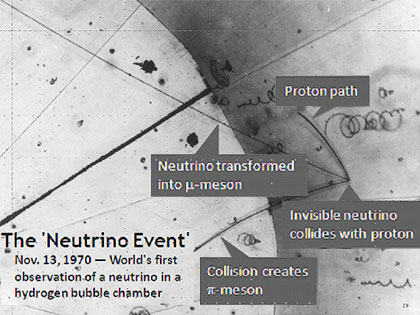
Neutrinos
Image: Argonne National Laboratory. A neutrino hit a proton in a hydrogen atom. The collision occurred at the point where three tracks emanate on the right of the photograph. Such events are extremely rare: a solar neutrino will typically penetrate about 4 light years of solid lead before being absorbed.
The neutrino is a light elementary particle without charge and with no known internal structure. It is of half-integral spin and constitutes, along with the electron and their antiparticles, the lightest of the three flavours of leptons (the others being the muon and tao particle). It was long thought to have zero mass, like the photon; however, recently it has been established there is a neutrino mass about one millionth of that of the electron.
Neutrinos are subject only to the weak nuclear force and have negligible interactions with ordinary matter. Because they are the lightest of the leptons they are also stable. The sun, like all main sequence stars, is the source of an intense flux of neutrinos: about 65 billion per square cm per second arrive at the Earth’s surface, through which they pass with virtually no effect. For these reasons neutrinos are among the most abundant particles in the universe. The electroweak force also violates parity: until the discovery that neutrinos have mass, it was thought that neutrinos of only one helicity exist in the world.
Because neutrinos interact so weakly, those emitted by supernovae carry information about the internal structure of exploding stars. Visible light and even X-rays and gamma-rays are scattered by gases, but not neutrinos, and there is a time-delay before reception at the Earth of electromagnetic emissions from supernovae in consequence. This depends on the shock waves produced, the structure of the star, and intervening gases and dust. This time difference can amount to more than an hour or two; in this way neutrino detectors monitoring the sky provide an advance warning system for supernovae explosions, the Supernovae Early Warning System.
The neutrino was predicted by Wolfgang Pauli in 1930, on the grounds that an uncharged and (virtually) massless fermion particle must be emitted in beta decay to maintain conservation of energy, momentum and spin. Direct confirmation came in 1956 with the work of Frederich Reines and his collaborators, for which Reines shared the 1995 Nobel Prize with Martin Perl, discover of the tau lepton.
Links
New Scientist March 2008: Universe submerged in a sea of chilled neutrinos >
Neutrino unbound: online e-archive >
Multimedia
Clyde Cowan, co-discoverer of the neutrino >
Fermilab - Neutrinos: nature’s identity thieves >
Fermilab - Neutrinos: nature's ghosts >

